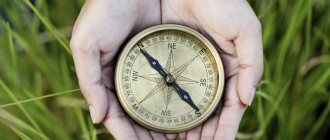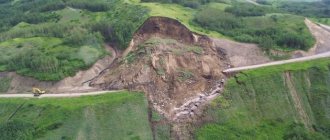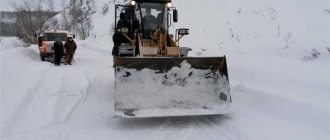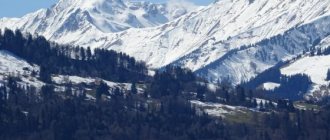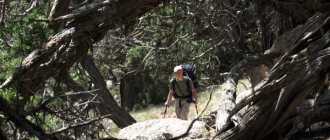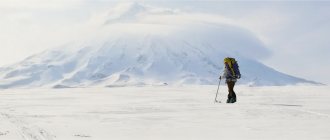What is a snow avalanche
An avalanche, as defined by glaciologists, is a type of landslide in which a significant volume of snow falls down a steep mountain slope. As you move, the snow formation increases as it absorbs more and more new portions of snow.
Of the main characteristics of the mountain phenomenon, the following should be noted:
- speed - on average 20 - 30 m/s (determined by the steepness of the slope);
- volume – up to million m3;
- pressure on blocking objects – up to 100 t/m2 (at this pressure, stone buildings are destroyed);
- the height of the layer of snow that has filled the valley is from 30 to 50 m;
- weight - up to several hundred tons (if the avalanche contains glacial inclusions, then its weight can reach hundreds of thousands of tons).
An avalanche is possible when the slope angle exceeds 25°, the height of the slope is 20 m and above, and the thickness of the fresh snow accumulated above the surface of the relief is more than 30 cm, old - 70 cm. When the fresh snow layer reaches 50 cm, the avalanche station specialists warn about the high probability of a dangerous phenomenon in the next 10 hours.
Snow can only fall from a slope on which no woody vegetation grows. Trees slow down the movement of the snow mass and prevent it from gaining speed. Avalanches occur in all high mountain areas of the planet. On the territory of Russia, the following areas are considered dangerous:
- Kamchatka ridges;
- Altai;
- Ural Mountains;
- Caucasus;
- Sayan Mountains;
- Baikal ridges;
- Khibiny;
- Verkhoyansk ridge;
- highlands of the Magadan region.
Characteristics of snow avalanches
Before a snowfall, a dull sound is heard high in the mountains, and then a huge snow mass moves at high speed from the top, sweeping away everything in its path. After stopping, a cloud of dust from the snow rises into the sky, forming a kind of fog.
Avalanches are most often possible on slopes with an angle of 25-45º. Under such conditions, the accumulated snow (its weight) exceeds the friction force, resulting in the movement of snow masses. A slope of less than 15º is considered safe.
The causes of avalanches are often thaws, rains, and heavy snowfalls. Therefore, it is necessary to pay attention to the climatic conditions of the region in order not to fall into the risk zone. You should also be wary of earthquakes and rockfalls, and sometimes even loud sounds and strong winds.
It is customary for ski resorts to put up flags indicating avalanche risk
- Minimal – the snow is stable, a strong impact will be required for a collapse.
The consequences of avalanches can be extremely dangerous. There were cases when melting snow destroyed entire infrastructure and entire settlements. And it’s already clear about the many deaths of skiers, snowboarders and other athletes and amateurs.
Factors causing an avalanche:
- composition (only snow, ice, or snow with ice);
- density and connectivity (dense, loose, monolithic, layered);
- layer thickness (thin, medium, thick);
- temperature (low, medium, high).
An avalanche remains one of the main dangers, which, with a certain attitude, can be, if not eliminated, then reduced in order to avoid unreasonable risk.
Causes
A snow avalanche occurs when a large volume of solid precipitation accumulates on a mountain slope over a period of time. The greatest snow accumulations are observed on slopes of 20 – 45°.
It is impossible to prevent avalanche danger, since the fall of solid precipitation is a natural process. Therefore, avalanche handlers - specialists in the warning service - either provoke a collapse of the snow mass in the absence of people on the slope, or prohibit visiting the mountain until the snow melts on its own.
The causes of snow avalanches are:
- heavy snowfalls, during which the snow cover thickens to a dangerous level;
- high air humidity, which makes the layer of accumulated sediment heavier;
- sudden change in weather conditions (changes in air temperature, atmospheric pressure);
- earthquakes, rock falls and other phenomena with powerful mechanical effects;
- human activity (for example, engineering and construction work accompanied by loud sounds and shaking of soil).
Dangerous avalanches: how to behave?
In an avalanche-prone area, the risk must be reduced. We must remember that the steepness of the slope, heavy snowfall, rain, warming are factors that increase the risk of an avalanche.
Some false ideas become dogmas. Intense frost is not a stabilizing factor for snow. If the cold was preceded by warming, there is no stabilization effect. Professionals (in particular, rescuers) are always ready to provide the necessary information. By constantly monitoring the snow cover, they will talk about the stability of the snow.
- You cannot rush headlong down, jumping from ridges and cornices. If there is any doubt about the snow, it is better to make an extra loop and settle for a less interesting descent to avoid the danger of an avalanche.
The chances of a person being caught in an avalanche rapidly decrease over time. The statistics are cruel: only 80% of people can survive an avalanche.
Then every hour the chances are cut in half. So, the time factor is paramount.
Classic search tools - probing, bloodhounds - are used if the victim does not have a detection system. Dogs do the same job as 30 rescuers; they are indispensable in terms of speed of implementation.
Today, the market offers electronic devices that help find people caught in an avalanche.
Classification of snow avalanches
There are several types of avalanches depending on the characteristics of movement, volume and consistency of the snow mass.
Based on the nature of movement, flows are distinguished:
- osovy – descending along the entire surface of the ridge:
- tray - sliding along hollows:
- jumping - taking off when colliding with obstacles while moving down:
Classification of avalanches by volume and consistency of snow mass includes flows:
- From dry powder snow, occurring during or after heavy snowfall. Snow is small, light air crystals. The flow is fluid and passes freely through obstacles. Develops speeds of up to 300 km/h.
- From dense, dry powder snow lying on the slope for more than a week. The accumulated layer of crystals is compressed and compacted. As a result, the avalanche moves slowly and forms a cloud above it.
- Created by snowstorms. Snow is carried by blizzards to the mountain slopes, from where it falls into the valleys.
- Landslides. They represent a gathering of snow cornices. Characterized by large volume.
- Dusty. Formed by the movement of a flow of the first type, they represent a large veil of snow dust, leaving a coating on trees and rocky surfaces. The travel speed can reach 400 km/h.
- Reservoir. The most dangerous. Layers of snow falling off a slope can move at speeds of up to 200 km/h.
- From hard layers of snow. Dense snow layers are destroyed, individual flat blocks descend along the loose base, picking up speed.
- Soft plastic. Soft, wet, moderately or heavily compressed snow slides down the slope surface.
- Monolithic ice or ice-snow. They represent the collapse of firn - heavy snow deposits, saturated with moisture, formed during temperature fluctuations, turning into ice over time.
- Complex. They consist of an upper dry snow cloud and a lower loose dense layer. They have powerful destructive power and are capable of demolishing a small village. The likelihood of a collapse increases after a thaw or rapid cold snap.
- Wet. They disappear during thaws and rainfall, when the snow cover is saturated with moisture.
- Wet. They occur during a thaw, when it rains and warm winds blow. The upper layer saturated with moisture slides along the lower old layer.
- Mudflow-like. They are a snow-water mass. Occurs as a result of prolonged thaw with rain.
Avalanches of powdery, dry recent snow
Such an avalanche usually occurs during heavy snowfall or immediately after it.
Powder snow is fresh, light, fluffy snow made up of tiny snow flakes and crystals. The strength of snow is determined by the rate of increase in its height, the strength of its connection with the ground or previously fallen snow.
It has quite high fluidity, which makes it possible to easily flow around various obstacles. In different cases they can reach speeds of 100–300 km/h.
How dangerous is an avalanche?
The strongest avalanches can destroy entire villages located in the valley. But this rarely happens, since they try not to build human housing in potentially dangerous places. The main consequences of the slope process are injury and death to people: climbers, skiers and other visitors to mountain resorts.
The likelihood of surviving an avalanche is slim. The shock wave breaks bones, the person dies from painful shock, even if he survives and is removed by rescuers, he remains disabled. Often victims are dug up with frostbitten limbs that have to be amputated. When a person becomes buried under a thick snow cap, he may suffocate due to lack of air space, or due to snow getting into the respiratory tract. Not all victims manage to wait for rescuers while in an ice sarcophagus.
There are preserved references to the largest avalanches of the 20th century:
- The world's largest series of avalanches caused by snowfall occurred in the Alps in 1951:
Almost 250 people died in Switzerland, Austria, and Italy. Several mountain villages have disappeared from the face of the planet. - In Austria, in 1954, in the village of Blons, two streams simultaneously descended from the mountains in January, killing more than a hundred local residents.
- In France in 1980, 280 guests of a ski resort became victims of the disaster.
- In 1910, in the US state of Washington, a huge snowfall hit a railway station. 10 people died:
Precursors of an avalanche
The main precursors include weather conditions and the state of the snow cover. You should not go to the mountains during heavy snowfall, rainy and windy weather. Also, even a slight sliding of loose and wet snow down the slope can be considered a sign of a potential avalanche.
In 1993, to determine the likelihood of a hazardous event, a risk system was created that included five levels. Each level is marked with a flag of a certain shape. These flags mark skiing and climbing areas at all mountain tourist sites so that vacationers can see the degree of danger. So:
- level I – minimal danger;
- level II – limited danger, snow in some areas is unstable;
- level III – medium danger, weak or medium stability of snow on steep slopes;
- level IV – snow is unstable, medium and large avalanches are possible on steep slopes;
- level V – high degree of danger, large avalanches are possible even on gentle slopes.
